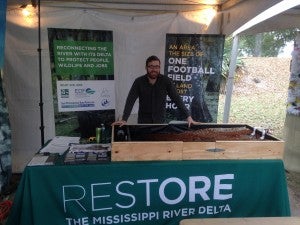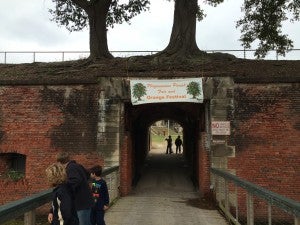River diversion model debuted at Plaquemines Parish Orange Festival
By Philip Russo, Outreach Coordinator, Restore the Mississippi River Delta Coalition
Land along a river has long been coveted for its agricultural productivity, but few rivers can compete with the mighty Mississippi.
With a drainage basin stretching across 31 U.S. states and parts of Canada, it is no surprise that the Mississippi River carries a lot of sediment. Historically, the river would deposit this sediment near its mouth in what is now southeast Louisiana, creating new land. But since leveeing of the river, the majority of this sediment is lost out the mouth of the river and into the deep waters of the Gulf of Mexico.
Near the mouth of the Mississippi, the final 85-mile stretch of the Mississippi River in Plaquemines Parish is home to prodigious citrus farming land. And with cool temperatures and clear skies, the weather of early December was ripe for the 68th Annual Plaquemines Parish Orange Festival.
Nestled between the Mississippi River levee and historic Fort Jackson, the focus of the festival is all things citrus. In Louisiana, that means copious displays of red navels, tangelos, ruby red grapefruits, sweet oranges, satsumas, kumquats and more.
While we attended and blogged about our trip down to the Orange Festival last year, this was the first year we actively engaged the crowds about protecting and restoring our coast – and we got to do so while debuting our tabletop river delta model! Watch this short video of the diversion model in action.
There are some sections of Plaquemines Parish where the distance between the Mississippi River levee and the Barataria Bay levee is only a few hundred yards, so Plaquemines residents are familiar with and usually eager to talk about their coast. But having a model demonstrating the process which built the very land everyone is standing adds another dimension to conversations about restoring barrier islands, ridges and marsh.
This year’s Orange Festival celebrated yet another successful harvest, but the celebration – originally organized in 1947 to promote Plaquemines’ citrus crop – has known its setbacks, most significantly due to Hurricanes Betsy, Camille and Katrina. If we are going to ensure the success of future harvests, we need to restore our multiple lines of defense against storm surge and maintain our protective coastal wetlands with strategically located and operated diversions along the river.


